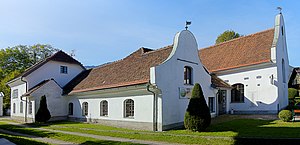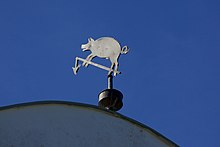Scythe forge Steinhub
|
|||

|
|||
| location | |||
| Address: | Hammerweg | ||
| Cadastral municipality: | Mittermicheldorf | ||
| Coordinates: | 47 ° 52 '50.7 " N , 14 ° 7' 51.1" E | ||
| history | |||
| Founding: | before 1588 | ||
| Shutdown: | 1966
|
||
| Character: | Wild boar (1830) | ||
The Steinhub , also Stainhub , Untere Stainhub or Faschinghub is a partially listed ensemble of industrial culture in Micheldorf in Upper Austria in the Kirchdorf an der Krems district . The scythe factory was built before 1588, was owned by the Stainhuber family for over 350 years and was shut down in 1966. Today the former scythe hammer houses the exhibition "Klangwelten".
location
The Steinhub is located on the upper reaches of the Krems in the cadastral community of Mittermicheldorf between the former scythe smiths on Aigen (Melcherl) and on Gries (Gradn). Together with them, she formed the Zeitlinger scythe factory from the 19th century.
history
A Hans Holzinger is mentioned as the first master at this workshop in 1587 . He was followed in 1588 by Christoph and Barbara Stainhuber . The forge was owned by her family for over 350 years. During the entire time the same sign "Werkmesser" (transverse knife) was struck, a tool used by the Lederer . Descendant Paul Stainhuber finally sold the property in 1824 to his neighbors Carl and Theresia Stainhuber from Gradnwerk , who handed the Steinhub over to their daughter Theresia and her husband Michl Moser in 1826 . These exchanged the Steinhub in 1830 with the scythe factory Grünau im Graben in Klaus des Caspar Zeitlinger , who in turn was married to a daughter of Carl Stainhubers. Since Michl Moser continued to use the old "Werkmesser" symbol in Klaus, Caspar Zeitlinger had a new "Wild boar" symbol recorded, which alludes to the founding legend of the Kremsmünster manor and can still be seen on the Steinhuberhammer today.
Buildings
The ensemble consisted of numerous buildings, a substantial part of which is still preserved today.
Steinhuberhammer
Former hammer building of the scythe forge "Untere Stainhub", adapted and expanded in 1831 with the inclusion of older material. Uniformly designed round gables with figure niches and double eagles, crowned by the hammer sign "wild boar". Table re. "Built by Caspar Zeitlinger and Josepha Zeitlinger in 1831". Originally preserved turbine house with Voith turbine, added around 1900, the oldest model of this type in the region. The Steinhuberhammer is a listed building and is now part of Upper Austria. Scythe forge museum the "worlds of sound".
Steinhub (mansion)
The manor house, the actual Steinhub , is dated "Built by Caspar Zeitlinger and Josepha Zeitlinger in 1837" on an oval plaque above the entrance door. The single-storey square courtyard was used as a residential and farm building.
Steinhuberhäusl
The Steinhuberhäusl (also Kärntnerhäusl or Köhlerhäusl), located between the hammer and the manor house, was one of the last originally preserved examples of a “Sengsschmiedhäusl” that was particularly valuable. In 2017 it was demolished and replaced by a new building.
Barn
In addition, one of the original several barns has been preserved. The carved initials "MM" (Michl Moser) and the old symbol "Werkmesser" can be seen above a gate. The fighter pieces are carved with the year “18” “41”. With its beautifully crafted details, the barn is a remarkable carpentry work of the 19th century.
See also
literature
- Franz Schröckenfux: History of the Austrian scythe works and their owners . Linz - Achern, 1975
- Franz Neumeyer: Heimatbuch Micheldorf (1997)

